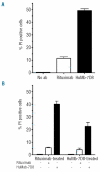HuMab-7D8, a monoclonal antibody directed against the membrane-proximal small loop epitope of CD20 can effectively eliminate CD20 low expressing tumor cells that resist rituximab-mediated lysis
- PMID: 20851867
- PMCID: PMC2995564
- DOI: 10.3324/haematol.2010.025783
HuMab-7D8, a monoclonal antibody directed against the membrane-proximal small loop epitope of CD20 can effectively eliminate CD20 low expressing tumor cells that resist rituximab-mediated lysis
Abstract
Background: Incorporation of the chimeric CD20 monoclonal antibody rituximab in the treatment schedule of patients with non-Hodgkin's lymphoma has significantly improved outcome. Despite this success, about half of the patients do not respond to treatment or suffer from a relapse and additional therapy is required. A low CD20-expression level may in part be responsible for resistance against rituximab. We therefore investigated whether the CD20-expression level related resistance to rituximab could be overcome by a new group of CD20 mAbs (HuMab-7D8 and ofatumumab) targeting a unique membrane-proximal epitope on the CD20 molecule.
Design and methods: By retroviral transduction of the CD20 gene into CD20-negative cells and clonal selection of transduced cells a system was developed in which the CD20-expression level is the only variable. These CD20 transduced cells were used to study the impact of rituximab and HuMab-7D8 mediated complement-dependent cytotoxicity. To study the in vivo efficacy of these mAbs an in vivo imaging system was generated by retroviral expression of the luciferase gene in the CD20-positive cells.
Results: We show that HuMab-7D8 efficiently killed CD20(low) cells that are not susceptible to rituximab-induced killing in vitro. In a mouse xenograft model, we observed a comparable increase in survival time between HuMab-7D8 and rituximab-treated mice. Most significantly, however, HuMab-7D8 eradicated all CD20-expressing cells both in the periphery as well as in the bone marrow whereas after rituximab treatment CD20(low) cells survived.
Conclusions: Cells that are insensitive to in vitro and in vivo killing by rituximab as the result of their low CD20-expression profile may be efficiently killed by an antibody against the membrane-proximal epitope on CD20. Such antibodies should, therefore, be explored to overcome rituximab resistance in the clinic.
Figures





Similar articles
-
Novel humanized anti-CD20 antibody BM-ca binds to a unique epitope and exerts stronger cellular activity than others.Cancer Med. 2013 Apr;2(2):130-43. doi: 10.1002/cam4.60. Epub 2013 Feb 20. Cancer Med. 2013. PMID: 23634281 Free PMC article.
-
Ofatumumab demonstrates activity against rituximab-sensitive and -resistant cell lines, lymphoma xenografts and primary tumour cells from patients with B-cell lymphoma.Br J Haematol. 2012 Feb;156(4):490-8. doi: 10.1111/j.1365-2141.2011.08966.x. Epub 2011 Dec 9. Br J Haematol. 2012. PMID: 22150234
-
Expression and biological characterization of an anti-CD20 biosimilar candidate antibody: a case study.MAbs. 2012 Jul-Aug;4(4):488-96. doi: 10.4161/mabs.20761. Epub 2012 Jul 1. MAbs. 2012. PMID: 22647435 Free PMC article.
-
What signals are generated by anti-CD20 antibody therapy?Curr Hematol Malig Rep. 2006 Dec;1(4):205-13. doi: 10.1007/s11899-006-0001-z. Curr Hematol Malig Rep. 2006. PMID: 20425315 Review.
-
Ofatumumab, a novel anti-CD20 monoclonal antibody for the treatment of B-cell malignancies.J Clin Oncol. 2010 Jul 20;28(21):3525-30. doi: 10.1200/JCO.2010.27.9836. Epub 2010 May 10. J Clin Oncol. 2010. PMID: 20458041 Review.
Cited by
-
Epitope mapping of antibodies to VlsE protein of Borrelia burgdorferi in post-Lyme disease syndrome.Clin Immunol. 2011 Oct;141(1):103-10. doi: 10.1016/j.clim.2011.06.005. Epub 2011 Jul 2. Clin Immunol. 2011. PMID: 21778118 Free PMC article.
-
Complement factor H-derived short consensus repeat 18-20 enhanced complement-dependent cytotoxicity of ofatumumab on chronic lymphocytic leukemia cells.Haematologica. 2013 Dec;98(12):1939-47. doi: 10.3324/haematol.2013.089615. Epub 2013 Jul 12. Haematologica. 2013. PMID: 23850806 Free PMC article.
-
How Do mAbs Make Use of Complement to Kill Cancer Cells? The Role of Ca2.Antibodies (Basel). 2020 Sep 4;9(3):45. doi: 10.3390/antib9030045. Antibodies (Basel). 2020. PMID: 32899722 Free PMC article. Review.
-
Monoclonal antibodies and recombinant immunoglobulins for the treatment of multiple sclerosis.CNS Drugs. 2012 Jan 1;26(1):11-37. doi: 10.2165/11596920-000000000-00000. CNS Drugs. 2012. PMID: 22171583 Review.
-
Novel humanized anti-CD20 antibody BM-ca binds to a unique epitope and exerts stronger cellular activity than others.Cancer Med. 2013 Apr;2(2):130-43. doi: 10.1002/cam4.60. Epub 2013 Feb 20. Cancer Med. 2013. PMID: 23634281 Free PMC article.
References
-
- Jemal A, Siegel R, Ward E, Murray T, Xu J, Thun MJ. Cancer statistics 2007. Cancer J Clin. 2007;57(1):43–66. - PubMed
-
- Marcus R, Hagenbeek A. The therapeutic use of rituximab in non-Hodgkin’s lymphoma. Eur J Haematol Suppl. 2007:5–14. - PubMed
-
- Groves FD, Linet MS, Travis LB, Devesa SS. Cancer surveillance series: non-Hodgkin’s lymphoma incidence by histologic subtype in the United States from 1978 through 1995. J Natl Cancer Inst. 2000;92(15):1240–51. - PubMed
-
- The Non-Hodgkin’s Lymphoma Classification Project: A clinical evaluation of the International Lymphoma Study Group classification of non-Hodgkin’s lymphoma. Blood. 1997;89(11):3909–18. - PubMed
-
- Fisher RI, Gaynor ER, Dahlberg S, Oken MM, Grogan TM, Mize EM, et al. Comparison of a standard regimen (CHOP) with three intensive chemotherapy regimens for advanced non-Hodgkin’s lymphoma. N Engl J Med. 1993;328(14):1002–6. - PubMed
Publication types
MeSH terms
Substances
LinkOut - more resources
Full Text Sources

